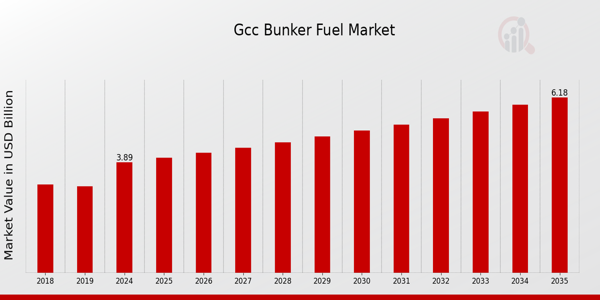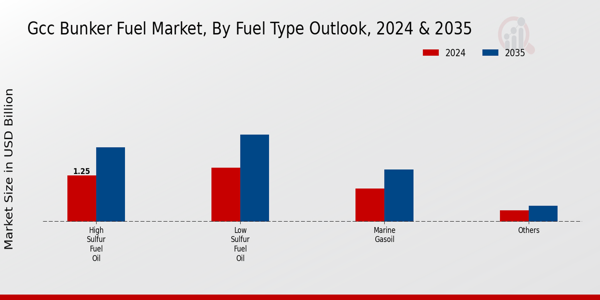GCC Bunker Fuel Market Overview
The GCC Bunker Fuel Market Size was estimated at 3.73 (USD Billion) in 2023. The GCC Bunker Fuel Industry is expected to grow from 3.89(USD Billion) in 2024 to 6.18 (USD Billion) by 2035. The GCC Bunker Fuel Market CAGR (growth rate) is expected to be around 4.3% during the forecast period (2025 - 2035).
Key GCC Bunker Fuel Market Trends Highlighted
In the GCC Bunker Fuel Market, there has been a noticeable trend towards the adoption of more environmentally friendly fuels. This shift is largely driven by stricter regulations aimed at reducing emissions from shipping, particularly those set by the International Maritime Organization. Countries in the GCC are increasingly aware of their environmental obligations, leading to investments in low-sulfur fuels and alternative energy sources. Furthermore, regional ports are enhancing their infrastructure to handle the storage and distribution of these cleaner fuels, making them more accessible for vessels. Opportunities in the GCC Bunker Fuel Market are significant, particularly in the development of new technologies, such as scrubbers, which help ships comply with emission regulations while continuing to use high-sulfur fuels.Furthermore, the expansion of key shipping channels through the Gulf Cooperation Council (GCC) region creates an avenue for bunker fuel suppliers to service growing regional and international maritime traffic. Another recently emerging change is the digitalization of some processes within the bunker fuel business. More companies are using data analytics to manage replenishment logistics, monitor fuel usage, and increase productivity. New systems are being designed to enhance transaction openness and improve confidence between suppliers and customers in the GCC. In general, the Gulf region’s Bunker Fuel Market is rapidly changing for the better due to growing regulations, new technologies, and the lack of meeting standards in environmental protection pertaining to maritime activities in the area.

Source: Primary Research, Secondary Research, MRFR Database and Analyst Review
GCC Bunker Fuel Market Drivers
Increase in Maritime Trade Activities in the GCC Region
The GCC Bunker Fuel Market Industry is significantly driven by the escalation of maritime trade activities across the Gulf region. As per the UAE Federal Competitiveness and Statistics Authority, the UAE's foreign trade reached over AED 2 trillion in recent years, marking a consistent annual growth of around 5%. This increase is attributed to the GCC's strategic geographical location that facilitates trade routes between Europe, Asia, and Africa. Major ports such as Jebel Ali in Dubai and Port Sultan Qaboos in Oman are enhancing their operational capacities and infrastructure.The International Maritime Organization's initiatives to improve shipping regulations and emissions standards also inspire growth in the drilling and shipping industry, thereby boosting demand for bunker fuels. With more ships navigating through these waters, the GCC Bunker Fuel Market is poised to benefit from the heightened bunker fuel consumption required to power these fleet operations.
Government Regulations Supporting Maritime Industry Growth
Regulatory frameworks set by GCC governments aiming to enhance the maritime sector are pivotal drivers of the GCC Bunker Fuel Market Industry. Initiatives like the Saudi Vision 2030 emphasize diversifying the economy, with a focus on bolstering the logistics and transportation sectors. The Qatar National Vision 2030 aims to enhance its role as a maritime hub, leading to significant investments in port infrastructure. Such enhancements not only increase fuel demand but also elevate operational standards, compelling shipowners to procure higher-quality bunker fuels to meet regulatory requirements.Additionally, FATF measures are being adopted to ensure compliance with international maritime rules, further strengthening the local industry and increasing the efficiency and competitiveness of maritime operations.
Investment in Renewable Energy Fuels
Investments in renewable energy and alternative fuel sources play a crucial role in shaping the future of the GCC Bunker Fuel Market Industry. The GCC governments are emphasizing sustainability, which is reflected in national strategies such as Saudi Arabia's National Renewable Energy Program, which targets generating a substantial share of energy from renewables. Reports indicate that investments in clean and renewable energy in the region could reach as high as AED 600 billion by 2030.This shift results in the exploration and potential adoption of biofuels and other sustainable bunker fuel options. While traditional bunker fuels will remain in demand in the short term, the gradual transition to these alternatives reinforces the overall demand for bunker fuels, thereby enhancing market growth during this transitional phase.
Growing Investment in Port Infrastructure
Substantial investment in port infrastructure across the GCC is a vital driver for the GCC Bunker Fuel Market Industry. For instance, the Saudi Ports Authority has committed over $4 billion to enhance port facilities over the coming years. Upgraded infrastructure will improve shipping capabilities, leading to increased cargo handling and greater maritime traffic. This growth translates to higher consumption of bunker fuel to service the expanding number of vessels utilizing these ports.Moreover, the establishment of economic zones and free trade agreements further boost regional trade, enhancing the utility of bunkering services. Consequently, an increase in port infrastructure development directly correlates to rising demand for bunker fuels in the GCC region.
GCC Bunker Fuel Market Segment Insights
Bunker Fuel Market Fuel Type Outlook Insights
The GCC Bunker Fuel Market exhibits a diverse Fuel Type Outlook that reflects the region's strategic maritime activities and regulatory landscape. High Sulfur Fuel Oil (HSFO) continues to play a crucial role due to its cost-effectiveness and wide availability, appealing to various shipping companies operating in less regulated areas. On the other hand, Low Sulfur Fuel Oil (LSFO) has gained prominence, especially with the implementation of stringent International Maritime Organization (IMO) regulations aimed at reducing sulfur emissions from ships, thereby complying with environmental standards.This shift signifies an important transition within the industry as it pivots towards more sustainable practices. Meanwhile, Marine Gasoil is increasingly favored for its lower environmental impact, serving as an alternative for vessels that aim to enhance operational efficiency and adhere to upcoming regulations. The overall demand dynamics in the GCC Bunker Fuel Market reflect shifting preferences toward cleaner fuels while maintaining economic competitiveness. Additionally, the rise of alternative fuels presents myriad opportunities for innovation and growth, particularly as the region recognizes the need for sustainability.The ongoing exploration of biofuels and LNG in the maritime sector further underscores the GCC’s commitment to advancing cleaner fuel options, showcasing its adaptability to an evolving global energy landscape. With these trends driving market behavior, it is imperative for stakeholders to remain informed of regulatory changes and their implications on fuel adoption across the GCC Bunker Fuel Market.

Source: Primary Research, Secondary Research, MRFR Database and Analyst Review
Bunker Fuel Market Commercial Distributor Outlook Insights
The Commercial Distributor Outlook segment of the GCC Bunker Fuel Market plays a crucial role in the overall dynamics of the industry, characterized by a diverse array of players, including Oil Majors, Large Independent Distributors, and Small Independent Distributors. The Oil Majors often dominate the landscape due to their extensive distribution networks and branding strength, facilitating large-scale operations and ensuring a consistent supply of bunkering fuels across key GCC ports. Large Independent Distributors, while having a significant position, focus on specialized services and flexible sourcing strategies that cater to regional customers' needs, enhancing competition and driving innovation.Meanwhile, Small Independent Distributors contribute to the market by providing niche services and localized solutions, which are important for customer engagement and satisfaction within specific markets. This diverse structure not only enhances market resilience but also stimulates growth opportunities, with GCC states emphasizing strengthening their maritime capabilities as part of broader economic diversification initiatives. The market faces challenges such as fluctuation in global oil prices and stringent environmental regulations, but opportunities abound as the GCC aims to position itself as a strategic maritime hub in the global shipping industry, promoting advancements in bunker fuel technology and sustainable practices.
Bunker Fuel Market Application Outlook Insights
The Application Outlook of the GCC Bunker Fuel Market showcases a diverse and strategic framework that plays a critical role in regional maritime operations. Key applications include Container ships, Bulk Carriers, Oil Tankers, General Cargo, Chemical Tankers, Fishing Vessels, Gas Tankers, and other vessels, each contributing to the market's evolution and significance. Notably, Container ships represent a majority holding, as they facilitate extensive trade routes throughout the GCC, benefiting from robust port infrastructure and logistical advancements.Bulk carriers follow closely, supporting the transportation of essential raw materials, thereby fortifying supply chains within the regional economy. Oil tankers remain pivotal, sustaining the oil and gas industry's dominance within GCC countries, while Chemical tankers enable the safe transport of various chemicals necessary for industrial operations. Fishing vessels contribute to regional food security and economic stability, highlighting the importance of sustainable practices within this segment. The growth of Gas tankers reflects the increasing demand for liquefied natural gas as a cleaner energy source, positioning the GCC as a critical player in global energy markets.As the landscape continues to evolve, the segments within the GCC Bunker Fuel Market remain integral to the growth dynamics, addressing both current trends and future opportunities amid global maritime developments.
GCC Bunker Fuel Market Key Players and Competitive Insights
The competitive landscape of the GCC Bunker Fuel Market has evolved significantly in recent years, driven by the increasing demand for marine fuels and regulations aimed at reducing emissions in shipping. This region, known for its vast oil reserves and strategic geographic location, plays a pivotal role in the global fuel supply chain, making it a crucial area for bunker fuel providers. Analyzing the competitive dynamics reveals a mix of established players and emerging companies, each leveraging their strengths to capture market share. Factors influencing competition include technological advancements in fuel production, regulatory compliance, sustainability practices, customer relationships, and service delivery efficiency. The GCC Bunker Fuel Market is characterized by a high degree of competition where companies strive to differentiate themselves through quality, pricing, and customer service.Chevron holds a strong position in the GCC Bunker Fuel Market, benefiting from its extensive experience in the energy sector and established reputation. The company's robust supply network and logistical capabilities enable it to provide reliable and consistent bunker fuel supplies across various GCC ports. Chevron's strengths are amplified by its commitment to meeting stringent environmental standards, which is increasingly crucial in today's market. The company invests significantly in innovation and sustainability, resulting in superior fuel options that meet customer demands while adhering to environmental regulations. Chevron's established relationships with vessel operators, shipping companies, and regional authorities further strengthen its presence in the market, allowing it to navigate the competitive landscape effectively.Gazpromneft Marine Bunker, as a player in the GCC Bunker Fuel Market, has made notable strides in establishing its market presence and enhancing its service offerings. The company specializes in providing high-quality marine fuels and lubricants tailored to the needs of the maritime sector. It emphasizes the importance of sustainability in its operations, aligning itself with the regulatory changes that are reshaping the industry. Gazpromneft Marine Bunker prides itself on its adaptability and responsiveness to market trends, allowing it to serve a diverse clientele across the GCC region effectively. Additionally, the company has engaged in strategic partnerships and joint ventures with local entities to enhance its market reach and operational capabilities. These initiatives, combined with a focus on delivering superior value through innovative products and services, position Gazpromneft Marine Bunker as a key player in the competitive landscape of the GCC Bunker Fuel Market.
Key Companies in the GCC Bunker Fuel Market Include
- Chevron
- Gazpromneft Marine Bunker
- Oman Oil Marketing Company
- Puma Energy
- Total Marine Fuels
- World Fuel Services
- ExxonMobil Marine Fuels
- BP Marine
- Bunker Holding
- Maritime and Port Authority of Singapore
- Port of Fujairah
- Vitol
- Shell Marine
- Saudi Arabian Oil Company
- Qatar Fuel Company
GCC Bunker Fuel Market Industry Developments
Recent developments in the GCC Bunker Fuel Market indicate a continued increase in demand amidst fluctuating oil prices and regulatory changes aimed at reducing sulfur emissions. In September 2023, reports highlighted that companies like ExxonMobil Marine Fuels and BP Marine are adjusting their fuel offerings to comply with stricter environmental standards, demonstrating responsiveness to market shifts. The Port of Fujairah has seen increased bunker fuel activity, with transactions reflecting a strong growth trajectory, attributed partly to a strategic push by Saudi Arabian Oil Company and Oman Oil Marketing Company to enhance supply capabilities. Notably, in August 2023, Vitol announced a partnership with Puma Energy to expand its bunkering services in the Gulf region. Furthermore, the Maritime and Port Authority of Singapore has collaborated with GCC nations to improve cross-regional fuel supply chains. Over the last two years, Total Marine Fuels and World Fuel Services have increasingly focused on integrating low-sulfur options into their portfolios to meet new international maritime regulations that came into effect in January 2020. This strategic direction by key players in the GCC underscores ongoing efforts to align with global sustainability initiatives.
Bunker Fuel Market Segmentation Insights
Bunker Fuel Market Fuel Type Outlook Outlook
-
High Sulfur Fuel Oil
-
Low Sulfur Fuel Oil
-
Marine Gasoil
-
Others
Bunker Fuel Market Commercial Distributor Outlook Outlook
Bunker Fuel Market Application Outlook Outlook
-
Container
-
Bulk Carrier
-
Oil Tanker
-
General Cargo
-
Chemical Tanker
-
Fishing Vessels
-
Gas Tanker
-
Others
| Report Attribute/Metric Source: |
Details |
| MARKET SIZE 2018 |
3.73(USD Billion) |
| MARKET SIZE 2024 |
3.89(USD Billion) |
| MARKET SIZE 2035 |
6.18(USD Billion) |
| COMPOUND ANNUAL GROWTH RATE (CAGR) |
4.3% (2025 - 2035) |
| REPORT COVERAGE |
Revenue Forecast, Competitive Landscape, Growth Factors, and Trends |
| BASE YEAR |
2024 |
| MARKET FORECAST PERIOD |
2025 - 2035 |
| HISTORICAL DATA |
2019 - 2024 |
| MARKET FORECAST UNITS |
USD Billion |
| KEY COMPANIES PROFILED |
Chevron, Gazpromneft Marine Bunker, Oman Oil Marketing Company, Puma Energy, Total Marine Fuels, World Fuel Services, ExxonMobil Marine Fuels, BP Marine, Bunker Holding, Maritime and Port Authority of Singapore, Port of Fujairah, Vitol, Shell Marine, Saudi Arabian Oil Company, Qatar Fuel Company |
| SEGMENTS COVERED |
Fuel Type Outlook, Commercial Distributor Outlook, Application Outlook |
| KEY MARKET OPPORTUNITIES |
Increased maritime trade activities, Transition to low-sulfur fuels, Expansion of regional port infrastructure, Growth in eco-friendly bunker options, Rising demand for decarbonization solutions |
| KEY MARKET DYNAMICS |
Rising shipping activity, Stringent environmental regulations, Price volatility, Technological advancements, Competitive pricing strategies |
| COUNTRIES COVERED |
GCC |
Frequently Asked Questions (FAQ) :
The GCC Bunker Fuel Market is expected to be valued at 3.89 billion USD in 2024.
By 2035, the GCC Bunker Fuel Market is projected to reach a value of 6.18 billion USD.
The anticipated CAGR for the GCC Bunker Fuel Market from 2025 to 2035 is 4.3 percent.
In 2024, the High Sulfur Fuel Oil segment is valued at 1.25 billion USD and is expected to hold a significant share.
Major players in the market include Chevron, Gazpromneft Marine Bunker, Oman Oil Marketing Company, and ExxonMobil Marine Fuels.
The Low Sulfur Fuel Oil segment is expected to be valued at 2.35 billion USD in 2035.
Marine Gasoil is expected to grow to a market value of 1.4 billion USD by 2035.
The market is expected to see growth opportunities driven by increased maritime activities and environmental regulations.
The competition is intense with many established companies like BP Marine and Shell Marine actively participating in the market.
Key trends include a shift towards low sulfur fuel options and increased demand for environmentally compliant fuels.
















